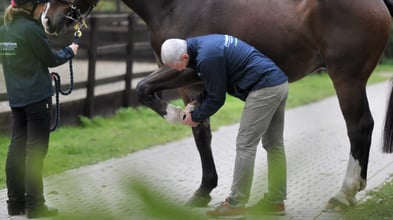Why Belgian vets are saying yes to objective gait analysis
Top Belgian equine veterinarians are clear: Objective gait analysis is becoming as essential as X-rays.

Dr. Gillian Tabor, is a researcher and clinician, an ACPAT Chartered Physiotherapist and Reader in Veterinary Physiotherapy at Hartpury University. With extensive experience in equine physiotherapy, she works with both competitive and non-competitive horses. Here’s what she has to say about her profession, objective gait analysis, vet referrals and closer communication with clients.
Physiotherapists help individuals—including horses—affected by injury, illness, or disability through movement and exercise, manual therapy, education, and advice. In equine physiotherapy, our goal is to return horses to their previous levels of function or even improve their performance beyond pre-injury levels. Additionally, we play a critical role in routine management to reduce the risk of injury.
As a physiotherapist, I often receive referrals from veterinarians for horses with various conditions, such as muscular pain, post-surgery recovery, or tendon and ligament rehabilitation. These referrals highlight the importance of a collaborative approach, where vets diagnose and treat medical conditions, and physiotherapists provide ongoing physical therapy to support recovery and prevent future injuries.
I spend extended time with each client, allowing me to perform comprehensive assessments. This approach enables me to screen for subtle or subclinical issues, not just focus on a single pathology or injury.
When visiting clients, I conduct thorough musculoskeletal assessments as part of the horse's general management plan. This includes taking a history, observing posture and conformation, and analysing muscle symmetry and hoof balance. A detailed palpation of soft tissues helps identify any signs of pain or dysfunction.
The frequency of visits depends on the horse’s training and season. Horses with high workloads or those competing at higher levels often need more frequent visits. If horses are working at or beyond their training level (known as overreaching), they may experience soreness and dysfunction. Physiotherapy can help manage these issues.
Assessing gait is a crucial part of my evaluation process. Observing the horse walking and trotting from different angles and on various surfaces helps me understand the horse’s movement and detect any abnormalities.
I also assess the horse on the longe to evaluate circular motion and transitions in and out of canter. Observing the horse during training can be helpful, especially if there are reported difficulties. For example, if there is difficulty with the left half-pass in the canter, that is what I would ask to see.
Although I am not a vet, I assess for lameness based on my postgraduate Veterinary Physiotherapy training at the Royal Veterinary College. My assessment focuses on identifying abnormal movements that could affect the horse's function, and whether the horse should be referred to the vet. Physiotherapists don’t diagnose the cause of lameness or its origin.
Previously, I relied solely on visual assessments to identify lameness. But as the research tells us, the ability to identify a mild lameness is challenging with a wide inter-observer variability. As one of my veterinary colleagues jokes – is it vet lame or physio lame?! My referral to him as a secondary lameness specialist is always with a lower sensitivity to mild lameness than he would expect!
Now, with the Sleip app, I can screen for asymmetries that are not visible to the naked eye. The data enhances my assessments but also enables more qualitative referrals and communication with veterinarians.
At Hartpury University, I’m fortunate to have access to objective gait analysis both using IMUs and 3-D motion capture. These are excellent, but neither is easy to translate into clinical physiotherapy practice.
As a mobile practitioner, the Sleip app’s ease of use is a significant advantage. I can set up my phone on a tripod and continue interacting with clients, and visually observing other factors of the gait while the app analyses movement symmetry. I assess for the quality of movement, such as spinal motion, limb placement, and patterns of muscular activation, in addition to a pure threshold value of lameness.
I work in some areas, notably in the southwest of England, where phone signals are poor, which means it takes a while to upload the recording and get the analysis result back from Sleip. I generally start with the recordings, and then I complete my visual assessment first and refer to the data afterwards. The app's ability to detect even very subtle asymmetries that I might miss visually is incredibly useful for refining my assessments.
Regular use of the Sleip app enables me to track and compare asymmetry levels over time, establishing baseline values for each horse. This helps me monitor changes and make informed decisions about the horse’s health and training regimen.
With over two decades in veterinary physiotherapy, I am experienced in managing difficult client communications. The Sleip app simplifies these conversations by providing clear, objective data. This helps explain the need for veterinary visits or why physiotherapy might not be suitable at a given time. It removes subjectivity and provides clear, objective information that supports my recommendations.
I also find that using objective data and making it routine to record the horses with Sleip gives clients peace of mind. They get to know their horse better and routine assessments can identify potential issues early. This proactive approach helps prevent injuries and ensures that horses receive timely and appropriate care.


Top Belgian equine veterinarians are clear: Objective gait analysis is becoming as essential as X-rays.

Giorgio Ricardi of Donnington Grove Equine Vets reveals how data-driven gait analysis enhances clinical decisions in complex lameness cases.

We sat down with UK Master Farrier Marc Jerram, who blends traditional skill with modern gait analysis to spot issues early and collaborate with vets on targeted solutions.